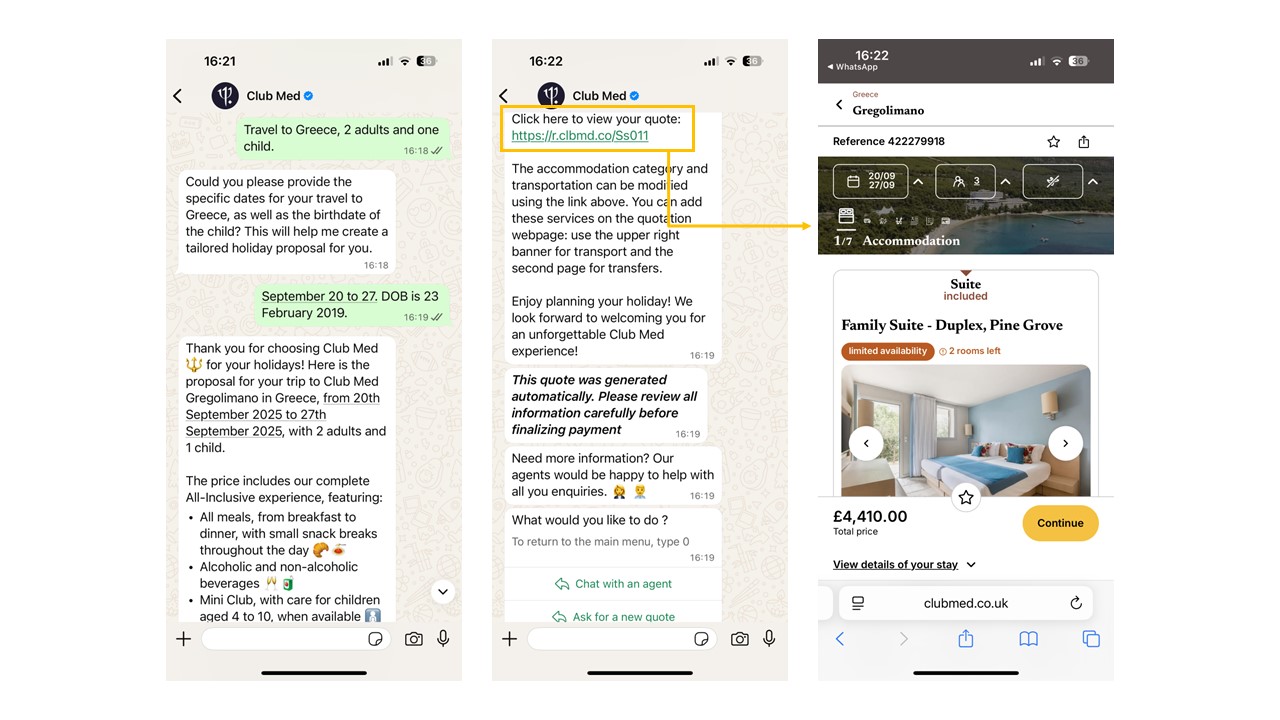Inside Club Med’s Conversational AI Strategy: An Interview With Siddhartha Chatterjee
AI is reshaping the future of digital experiences. With rapid advancements in AI, chatbots and virtual assistants are becoming more conversational, intuitive, and impactful. Organizations are racing to harness these innovations to enhance CX and boost operational efficiency. However, the path to transformation isn’t without its hurdles — navigating complex technologies and managing associated risks remain critical challenges.
To explore how one organization is tackling this journey, I interviewed Siddhartha Chatterjee, global chief data and AI officer at Club Med. Club Med is a global travel and tourism operator headquartered in Paris. The company has leveraged genAI for conversational experiences and has been on an AI transformation journey. We also welcomed Siddhartha for an exclusive fireside chat at Forrester’s CX EMEA Summit on June 4, 2025. There, he shared how Club Med designed, implemented, and continuously refined its conversational AI strategy — offering a rare, behind-the-scenes look at a real-world transformation in the travel and hospitality industry.
AI Leadership And Organization
Aurelie: Could you please tell us about your role at Club Med?
Siddhartha: My role is quite broad, akin to that of a chief data and AI officer with a strong focus on transformation. I have the privilege of working in an organization where marketing, digital, data, and AI are all integrated under one umbrella. I’m responsible for end-to-end data and AI initiatives, including infrastructure and IT, development and sourcing of AI and data use cases, data governance and compliance, and enhancing digital experiences across platforms.
Revolutionizing Customer Engagement With Conversational AI
Aurelie: What sparked the conversational AI initiative?
Siddhartha: The development of our WhatsApp chatbot was a very bold move. Our goal was to improve customer service efficiency. Since WhatsApp is widely used in Brazil — second only to India, with nearly 80% of customers using it to ask questions — we integrated our LLM-based AI directly into WhatsApp. At the time (early 2024), this was a novel approach. Within three months, we fully automated 30% of customer interactions (50% partially) — and improved customer satisfaction. Our vision is to enable the entire booking journey within WhatsApp, leveraging asynchronous messaging for both customers and service providers. AI enables us to provide near-instant responses. Inspired by innovations like JioMart in India, we’re working with Meta to expand this model in Europe, where adoption of WhatsApp for business is growing. We believe messaging is the future of customer engagement, but we remain omnichannel — offering consistent experiences across app, web, phone, and messaging. Ultimately, great CX is about how well services are delivered. We take a data-driven approach, constantly analyzing customer feedback and call center data to identify pain points and improve. We work with a range of vendors to ensure customer data privacy and security.

Enhancing Efficiency And Experience With A Multi-Agent AI System
Aurelie: There are many use cases for conversational AI, such as customer service, marketing, sales. Which use cases have delivered the most value for you and your customers?
Siddhartha: Automating responses has significantly improved both customer and sales agent experiences. Previously, agents acted like “human APIs,” manually retrieving information from databases — an inefficient use of their time. Now, a chatbot handles routine queries, freeing agents to focus on delivering a premium, emotionally engaging customer experience. One key metric: thanks to AI, the average first-response time on WhatsApp dropped by 3.5 hours, from around 4–6 hours to just 30–40 minutes. AI responses are nearly instant (4–5 seconds) with 95% answer accuracy, increasing satisfaction rates to 85%. The remaining 5% of answers that we want to improve aren’t hallucinations but could be more complete.
This success is due to a multi-agent AI system: One agent interprets the question, a second retrieves relevant data, a third generates the response in Club Med’s tone, and a fourth checks relevance. Human testers then score answers as perfect, partially complete, or incorrect. This rigorous evaluation process enables continuous improvement and confident scaling.
Smart Scaling: Localizing And Expanding The AI Assistant Across Markets
Aurelie: How has your conversational assistant evolved since its inception?
Siddhartha: We launched in Brazil in Q1 2024. As of Q2 2025, our AI assistant is live in 12 markets, each with unique languages, questions, and localized product details. Due to data limitations, some queries still go to human agents. We’re now adding a commercial information agent to handle localized promotions and building a booking agent that can place nonpayment holds on trips, streamlining the path from inquiry to booking.
We prioritize markets based on WhatsApp adoption and volume. Initially, we launched WhatsApp and AI together in Brazil and Belgium. Now, every WhatsApp rollout includes AI, with a two-week gap to analyze local queries for better performance. Our AI was built after analyzing call center data across markets, identifying two key question categories: product and pricing. The first two agents — product information and pricing — cover about 70% of customer queries. Pricing is complex, requiring real-time API calls and contextual explanations (e.g., why one resort costs more than another). Once a customer receives product and pricing info, we generate a prefilled booking link: This eliminates the need to manually search and input details, making the booking process much faster and more seamless.
Measuring Success
Aurelie: How do you define and measure success for your conversational AI initiatives? Are there any metrics or KPIs you focus on? Can you share a case where conversational AI helped reduce costs or improve efficiency in a measurable way?
Siddhartha: We track several KPIs to evaluate our AI tools. First, productivity: Are internal teams becoming more efficient? Then, the automation rate: What percentage of business processes are fully automated (e.g., 32% in WhatsApp, 75% for IT ticket routing)? We measure customer satisfaction, especially for customer-facing tools, and we monitor CSAT and Net Promoter Score℠ (NPS). And we also measure cost avoidance: Rather than cutting costs, we focus on avoiding future expenses through AI-driven efficiencies. We also benchmark a lot. For example, we were impressed by how Trip.com in China implemented conversational AI. They shared that it boosted conversions by 10–30% on certain offers. In UX-heavy environments like websites or e-commerce, metrics like conversion rate become much more critical than on simpler platforms like messaging apps.
Aurelie: Siddhartha, many thanks for that conversation and sharing your valuable insights.
Siddhartha: Thank you so much!
